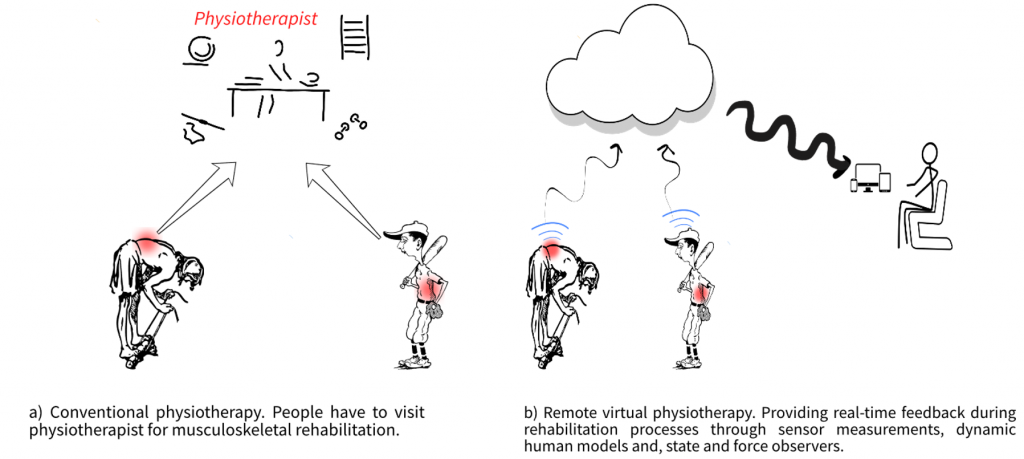Remote Virtual Physiotherapist (REVIP, Academy of Finland proj)
Project time Q4/2022 – Q3/2026. Consortium: LUT Machine design, UEF HUMEA Lab, JYU Sport and Health Sciences
Due to the declining populations in developed countries, retirement ages are going up, and the workforce is getting older. Aging in the physical labor workforce presents a unique challenge. This project seeks to address that challenge by developing real-time computation procedures to automate and optimize musculoskeletal rehabilitation. The procedures that will be developed will also enable wearable technologies that will help to prevent musculoskeletal disorders. In the new procedures, sensor signals will be used directly to actuate dynamic biomechanical computer models based on multibody system dynamics. The computer models will be synchronized to dynamic measurements of human motion using advanced state and force observers, enabling them to draw conclusions regarding biomechanical parameters and performance. The information gained will be used as a “remote virtual physiotherapist” to provide realtime
feedback during rehabilitation processes.
This project develops real-time computation procedures to automate and optimize musculoskeletal rehabilitation. In the new procedures, sensor signals (primarily inertial measurement units) will be used directly to actuate dynamic biomechanical computer
models based on multibody system dynamics. When compared to the existing computational procedure, this is revolutionary as it does not require inverse dynamics or muscle-controller optimization.
In the procedure being developed, the computer models will be synchronized to dynamic measurements of human motion using advanced state and force observers, which will enable them to draw conclusions regarding biomechanical parameters and performance. The overriding goal will be to develop a new biomechanical analysis procedure that for the first time can provide essential joint and muscle load information (forces and moments) in real time. The information gained will be used as a “remote virtual physiotherapist” to provide real-time feedback during rehabilitation processes. To ensure real-time operation, the project will make a use of efficient multibody formulations such like the double-step semi-recursive formulation and state-of-the-art computer implementations.
Currently, knee loads resulting from osteoarthritis rehabilitation exercises are estimated offline based on prior laboratory measurements. Introducing a real-time capability to estimate joint loads, critical for joint cartilage health, will enable instant detection of harmful loads. By estimating the loads on joints and the spine in real-time, rehabilitation exercises can be performed at more effective, but still safe, load levels. The instant detection of harmful loads will also make it possible to select more suitable exercises for each individual and make it easier to define the optimal way to perform each exercise. Moreover, real-time estimates will help to establish the most suitable
levels of both muscle and joint loading, which is key to improving muscular strength.
